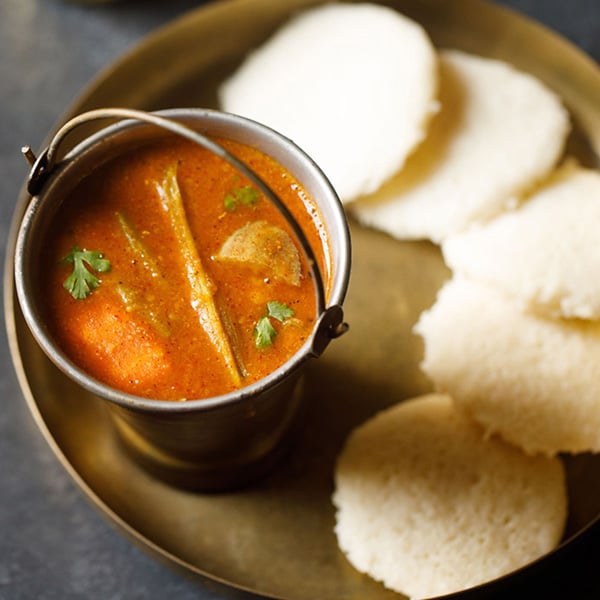Idli Sambar (Hotel Style Tiffin Sambar)
4.7
(35)
Your folders
Your folders
Prep Time: 20 minutes
Cook Time: 30 minutes
Total: 50 minutes
Servings: 5
Author : Dassana Amit

Ingredients
Export 25 ingredients for grocery delivery
Instructions
Step 1
Rinse both the lentils well and then add them in a 2 litre pressure cooker with 1.25 to 1.5 cups water and ¼ tsp turmeric powder.
Step 2
Pressure cook the lentils for 7 to 8 whistles or 11 to 12 minutes until the lentils have softened and well cooked.
Step 3
You can also cook the lentils in a pan on a stove top or in the instant pot. I recommend to soak the lentils for about 30 minutes in enough water prior to cooking them in a pan. This helps in the faster cooking of the lentils.
Step 4
Once the pressure settles down naturally in the cooker, open the cooker. Mash the lentils with a wired whisk and spoon. Keep aside.
Step 5
In a small and heavy frying pan, heat 2 teaspoons oil. Keep the flame to a low. First, add the mustard seeds.
Step 6
Then add the coriander seeds, cumin seeds, black pepper, chana dal (bengal gram), fenugreek seeds, curry leaves and dry red chillies.
Step 7
On a low flame stir non-stop and roast till the spices become aromatic and golden.
Step 8
Keep aside to cool. Don't burn the spices.
Step 9
Once the spices cool, grind them to a powder in a dry grinder or coffee grinder. Keep aside.
Step 10
Soak the tamarind in warm water for 25 to 30 mins.
Step 11
Later squeeze the tamarind in the soaked water and extract the tamarind pulp. You can strain tamarind pulp and keep aside.
Step 12
Chop all the veggies. Quarter the onions or halve the pearl onions. Peel and dice the carrots and potatoes.
Step 13
Dice the brinjals and add them in water to prevent discoloration.
Step 14
Chop the tomatoes in small pieces.
Step 15
In a pan, heat oil first. Add the mustard seeds and let them begin to crackle. Then add the urad dal and sauté till they turn to a maroonish color.
Step 16
Add quartered onions or halved pearl onions, curry leaves and asafoetida. Stir and saute for 2 minutes till the onions soften a bit.
Step 17
Add the tomatoes, salt as required and continue to saute for 4 to 5 minutes on a medium-low flame.
Step 18
Then add the veggies which take a longer time to cook (carrots, beans, potatoes, drumsticks etc) and saute for 4 to 5 minutes on a medium-low flame.
Step 19
Then add remaining quick-cooking veggies like brinjals, ladyfingers (okra), pumpkin etc now. Stir and mix.
Step 20
Add the tamarind pulp and 1 to 1.25 cups water.
Step 21
Season with salt as per taste. Mix well.
Step 22
Cover pan and simmer until the raw aroma of the tamarind goes away and the veggies are almost cooked.
Step 23
If the veggies are undercooked, then continue to simmer till they are almost cooked.
Step 24
Add the ground sambar powder which we have already prepared. Mix well.
Step 25
Add the mashed dal.
Step 26
Add 1 cup water or as required depending on the consistency you want. The sambar which is served in the hotels is on the thinner side. For idli, dosa and medu vada you can keep the sambar having a medium to thin consistency. For serving with rice, keep the tiffin sambar slightly thick.
Step 27
Stir and simmer without lid for about 6 to 7 minutes or till it comes to a boil. Stir at intervals.
Step 28
Check the taste and add more salt if required.
Step 29
Meanwhile when you keep the dal for pressure cooking, you can steam idli. Both small-sized mini idli or large idli goes well with tiffin sambar.
Step 30
While serving place the idli in a serving bowl. Pour sambar. Garnish with some coriander leaves. You can even drizzle a bit of ghee on top. Serve idli sambar hot.
Step 31
You can also garnish with coriander leaves and serve hot with medu vada, idli, dosa, uttapam or even with steamed rice.